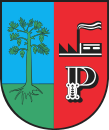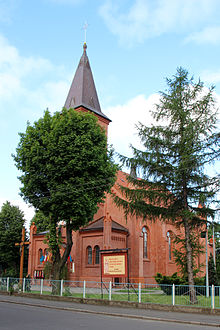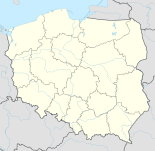Pieńsk
| Pieńsk | ||
|---|---|---|

|
|
|
| Basic data | ||
| State : | Poland | |
| Voivodeship : | Lower Silesia | |
| Powiat : | Zgorzelec | |
| Area : | 9.81 km² | |
| Geographic location : | 51 ° 15 ' N , 15 ° 3' E | |
| Height : | 197 m npm | |
| Residents : | 5828 (Jun. 30, 2019) |
|
| Postal code : | 59-930 | |
| Telephone code : | (+48) 75 | |
| License plate : | DZG | |
| Economy and Transport | ||
| Street : | Zgorzelec - Zielona Góra | |
| Rail route : | Węgliniec – Zgorzelec | |
| Next international airport : | Wroclaw | |
| Dresden | ||
| Gmina | ||
| Gminatype: | Urban and rural municipality | |
| Gmina structure: | 9 school offices | |
| Surface: | 101.33 km² | |
| Residents: | 9068 (Jun. 30, 2019) |
|
| Population density : | 89 inhabitants / km² | |
| Community number ( GUS ): | 0225043 | |
| Administration (as of 2018) | ||
| Mayor : | Jan Magda | |
| Address: | ul.Bolesławiecka 29 59-930 Pieńsk |
|
| Website : | www.piensk.com.pl | |

Pieńsk [ 'pʲɛɲsk ] ( German Penzig , Upper Sorbian Pjeńsk ) is a city with about 6000 inhabitants in southwest Poland . It is located 13 km north of Görlitz east of the Lusatian Neisse and belongs to the powiat Zgorzelecki in the Lower Silesian Voivodeship . The city is a member of the Euroregion Neisse and forms an urban and rural municipality with the surrounding villages .
history
In the Middle Ages, the town of Penzig was the seat of an important manor in Upper Lusatia . The Lords of Penzig , who can be verified for the first time in 1241, owned extensive property and towns on both sides of the Neisse. Because of the extensive lawn iron ore deposits in the Penziger Heide , several iron hammers were built in Penzig and the village became a residential area for the hammer workers. In 1329 the lords of Penzig were given essential privileges for the entire area of the Görlitzer Heide between the Neisse and Queis rivers. In 1390 the Muskau dominion came into their possession. In 1395 the forest area between the Neisse and Kleiner Tschirne became part of the Penzig dominion as Penziger Heide .
In the course of the 15th century, the domain within the family was split up into numerous small estates and lost all importance. In 1491/92 the city of Görlitz acquired the Penziger Heide, which it combined in 1499 with the forest area between Großer and Kleiner Tschirne to form Görlitzer Kommunalheide . Apart from a brief loss of property as a result of the Pönfall, this 279 km² forest area remained in the possession of the city of Görlitz until 1945. In order to make Penzig's affiliation with the city clear and to prevent it from being used again as an aristocratic residence, the Görlitz council had Penzig Castle demolished.
Since the middle of the 16th century, the importance of Penzig declined. The competition between the ironworks for Sprottau grew, and the new and modern ironworks, such as on the Malapane in Upper Silesia , led to the hammers being shut down.
During the Thirty Years' War , Penzig, like all of Lusatia , passed from Bohemian to Saxon rule. After 1800, Penzig sank significantly behind Rothwasser, which as the center of the cattle and horse trade had temporarily become the largest town on the heath. When Upper Lusatia was divided, Penzig came to Prussia and was part of the Görlitz district from 1816 to 1945 .
After 1850, the discovery of large deposits of brown coal in the Görlitzer Heide led to the development of Penzig as an industrial center. The railway connection from Görlitz via Penzig to Kohlfurt , inaugurated in 1847, offered ideal conditions for building a glass factory in the sandy area in addition to coal as fuel .
The water power of the Neisse was used until 1945 by a large grain mill ("Schreibermühle", also "Untermühle" to distinguish it from the "Obermühle" in Görlitz, which is also owned by the family) and finally also by a turbine power station, which the owner of the mill, Wilhelm Schreiber, built in the 1920s. The power plant supplied Görlitz until the end of the war, but was then dismantled and taken to the Soviet Union as spoils of war . Today a small turbine house stands on the site of the former mill.
During the fighting at the end of the Second World War , Penzig was badly damaged. After the end of the war, the town came to Poland on the basis of the Potsdam Agreement , and the German residents were expelled . The glassworks of the famous glass artist Richard Süßmuth found a new home in Immenhausen in northern Hesse .
Three of the destroyed glassworks were rebuilt, and machine and plant construction companies were created that were specially oriented towards the glass industry, so that Pieńsk became one of the most important locations for glass production in Poland.
The place, which had been a city-like settlement since 1954, received full city rights in 1962 .
Population development
| year | Residents |
|---|---|
| 1825 | 630 |
| 1860 | 988 |
| 1905 | 6,368 |
| 1939 | 7,305 |
| 1961 | 4,900 |
| 1970 | 5,302 |
| 1995 | 6.232 |
| 2005 | 5,925 |
Partnerships
The city of Pieńsk has a partnership with the small German town of Rothenburg / OL, 15 kilometers away . Gmina Pieńsk has a partnership with the municipality of Neißeaue , south of Rothenburg / OL .
In October 2008, another partnership agreement was signed with the community of Runde near Weißwasser, after partnerships already existed on a cultural level.
Gmina
The urban and rural municipality ( gmina miejsko-wiejska ) Pieńsk covers an area of 110 km², on which about 9200 people live. These include the following localities:
- Bielawa Dolna ( Lower Bielau )
- Bielawa Górna ( Upper Bielau )
- Dłużyna Dolna ( Nieder Langenau )
- Dłużyna Górna ( Ober Langenau )
- Lasów ( Lissa )
- Pieńsk ( Penzig )
- Stojanów ( Lower Penzighammer )
- Strzelno ( Schützenhain )
- Żarka nad Nysą ( Sercha , 1937–1945: Burgundenau )
- Żarki Średnie ( Sohra , 1937–1945: Kesselbach NS )
The Tormersdorf desert lies in the northernmost part of the municipality .
Personalities
sons and daughters of the town
- Johann Gottfried Geißler (1726–1800), teacher and librarian
- Wilhelm Winkler (1842–1927), educator, author and promoter of tourism in the Giant Mountains
- Minna Reichert (1869–1946), women's rights activist and politician, born in Nieder Bielau
- Fritz Hirche (1893–1945), criminal investigator, participant in the T4 campaign and the Reinhardt campaign
- Gerd Tacke (1906–1997), CEO of Siemens AG
- Georg Rösler (1921–2001), politician (CDU), member of the Schleswig-Holstein state parliament
- Horst Schneider (1927–2018), historian
- Ernst Koch (* 1930 in Nieder Langenau), Lutheran theologian
- Hans-Dieter Krüger (1930–2012), journalist, editor-in-chief
- Norbert Baumert (1932–2019), professor of New Testament theology at the Philosophical-Theological University of St. Georgen
- Manfred Glotz (1942–1965), victim on the inner-German border
- Hans-Werner Köblitz (* 1945), politician (free voters), district administrator of the district of Calw
Other people connected with the city
- Gottfried Schreiber (1918–2003), veterinarian, president of the Hesse Chamber of Veterinarians, childhood years in Penzig
- Richard Süßmuth (1900–1974), glass artist, ran a glass art workshop in Penzig
literature
- Hermann Knothe: History of the Upper Lusatian nobility and its goods from the XIII. until the end of the XVI. Century . Breitkopf & Härtel, Leipzig 1879 ( limited preview in the Google book search - gentlemen of Penzig localities, acquisition of towns by forest).
- Moritz Rösler: Chronicle of the village of Penzig. Gretsel, Görlitz 1864, urn : nbn: de: bsz: 14-db-id3966377442 .
Web links
- Website of the City and Municipality of Pieńsk (Polish)
- Görlitz, Penziger Heide on a map from 1645 ( Memento from May 3, 2004 in the Internet Archive ) (German legend)
Individual evidence
- ↑ a b population. Size and Structure by Territorial Division. As of June 30, 2019. Główny Urząd Statystyczny (GUS) (PDF files; 0.99 MiB), accessed December 24, 2019 .
- ↑ a b Hans Schulz: Beyond the Neisse . 1st edition. StadtBILD-Verlag, Görlitz 2007, ISBN 978-3-939655-38-1 , p. 106 .
- ↑ Regina Weiß: Two clubs laid the foundation stone. In: Lausitzer Rundschau . Local review for Weißwasser and Niesky. October 9, 2008 ( lr-online.de ( memento from March 7, 2016 in the Internet Archive )).
- ↑ The hiker in the Giant Mountains. Issue 532, December 1, 1927, p. 173.

